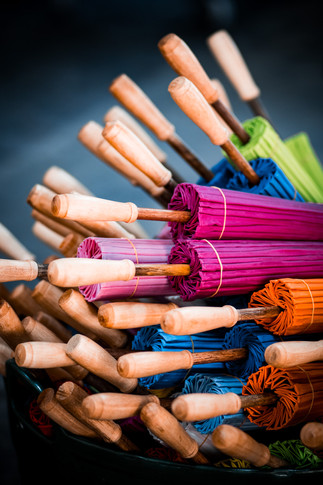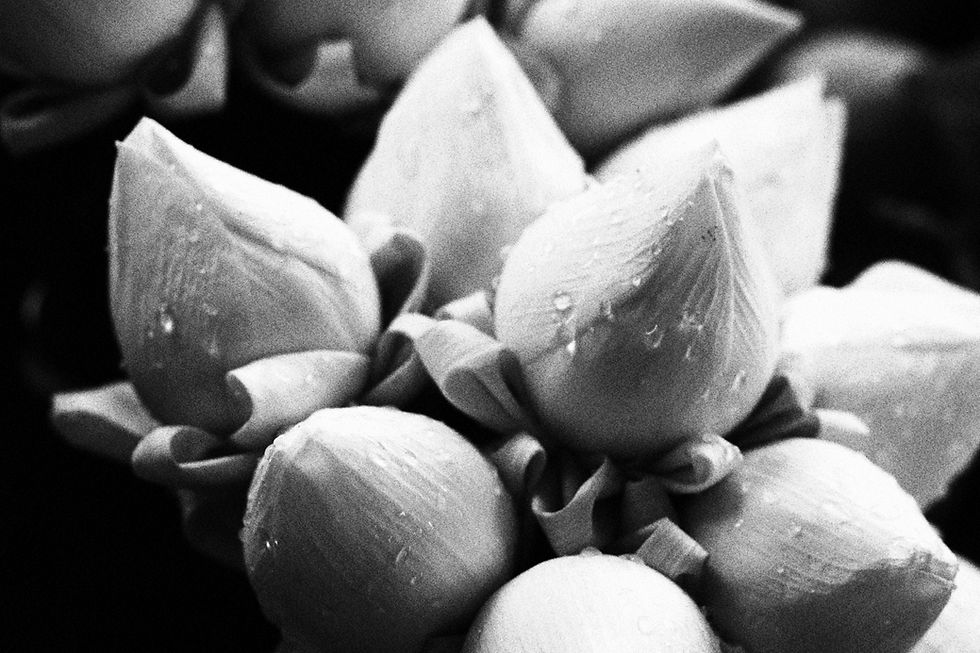Bo Sang Umbrella Village: A Portrait of Tradition, Color, and Craft
- Tatiana Mocchetti
- Jun 30
- 4 min read
Where Color Meets Calm
A twenty-minute ride east of Chiang Mai delivers you to a world painted in pastels and lacquer. In Bo Sang, umbrellas dangle like oversized blooms, gently spinning in the afternoon breeze. Paper rustles, laughter drifts from open-air workshops, and the sweet scent of saa-bark glue hangs in the air. This isn’t a museum frozen in time; it’s an active, living studio where craft still outpaces commerce and every brushstroke carries a memory.As photographers, we’re often drawn to grand vistas or dramatic light. Bo Sang teaches a different lesson: beauty lives in repetition, in slow hands, in pigment drying under a tin roof. Walk slowly, listen first, and let these scenes of patience guide your lens.

A Brief History of Bo Sang’s Umbrella Craft
Bo Sang’s story begins with a journey. Local lore credits a Lanna monk named Phra Intha who, returning from a pilgrimage in Burma more than a century ago, brought home a simple bamboo-and-paper parasol. Impressed by its lightness and utility, villagers reverse-engineered the design. The timing was perfect: Chiang Mai’s proximity to mulberry trees (the source of saa paper) and abundant bamboo groves made raw materials cheap and local.
From Market Staple to Cultural Icon
Late 19th century: Umbrellas serve farmers and monks, shielding them from sun and monsoon showers.
Mid-20th century: Decorative motifs—orchids, peacocks, temple spires—emerge as tourism grows after WWII.
1982: The first Bo Sang Umbrella & Sankampaeng Handicrafts Festival is held, cementing the village’s reputation and drawing international buyers.
Today: Family workshops compete with factory replicas, yet Bo Sang remains one of the few places where each umbrella can still be traced back to a single artisan’s hands.
Craft here is matrilineal: grandmothers teach daughters, who teach grand-daughters. Look closely and you’ll notice minute stylistic signatures—a certain way leaves curl on one woman’s umbrellas, or the three-dot “stars” that mark another’s work like an artist’s hidden signature.
What to Photograph in Bo Sang Umbrella Village
1️⃣ Wide-Angle Workshop Atmospheres
Step inside the open sheds: bamboo ribs stacked like musical staffs, vats of indigo and vermilion, floorboards stained by decades of pigment. Overhead, half-finished umbrellas form impromptu chandeliers.
2️⃣ The Hands that Carry the Craft
A lifetime of repetition carves stories into skin. Fingers stained pink from cochineal dye, calluses where bamboo splits, gold flecks under nails. Capture the tactile poetry.
Detail series: Glue being applied with a sliver of bamboo; fingertips smoothing paper; tiny scissors trimming fringe.
Lighting hack: Position yourself so side-light skims across fingers, revealing texture. Bring a small reflector (even a phone screen on white) to bounce soft light on shadowed palms.

3️⃣ Portraits of the Umbrella Makers
Many artisans are in their sixties or seventies—keepers of an almost-endangered knowledge. Approach with a smile, greet in Thai (“Sawasdee ka/krap”) before raising your camera.
Ideas to try
Environmental portrait: Subject framed by hang-drying umbrellas, using a 35 mm to show context.
Mid-process candid: Capture concentration—eyes down, brush mid-air.
After-work moment: A laugh shared over tea, paint-splattered apron still on—perfect for storytelling.
Insider tip: Offer to WhatsApp or LINE them the finished photo. Many proudly share images with family, turning an impromptu shoot into a cherished keepsake.
4️⃣ Painted Umbrella Designs in Detail
Umbrella surfaces are as diverse as Thai textiles. Besides classic florals, you’ll find:
Scenes from the Ramakien (Thai epic)
Celestial motifs—white elephants, Nagas, Garudas
Modern twists: cartoon elephants or personal names on request
Use macro or close-focus: isolate a blooming lotus, let background umbrellas blur into color washes. Play with backlight; thin saa paper glows, revealing fibers like veins in a leaf.
5️⃣ Life Beyond the Workshop
Stroll the alleyways: cats nap in paint-splashed crates; monks bicycle past pastel walls; children chase kites made from leftover paper. Each vignette balances the crafted with the candid.
Compositional prompts
Contrast: A bright umbrella against a corrugated-metal fence.
Layering: Frame a street scene through the spokes of an unfinished parasol.
Reflection: Catch umbrellas mirrored in puddles after a quick tropical downpour.
Visiting During the Bo Sang Umbrella Festival
Every third weekend of January, the village erupts in a riot of color. Umbrellas float above main street like confetti, traditional dancers perform the Fon Thien candle dance, and locals compete to paint the most intricate parasol.

📷 Practical Photography Tips
Arrive early – Workshops open around 9 AM. Soft morning light filters through slatted roofs.
Mind the varnish – Freshly lacquered umbrellas are delicate; avoid leaning or placing gear nearby.
Respect pauses – When artisans pray or make offerings at spirit houses, lower your camera.
Bring a polarizer – Cuts glare on lacquered surfaces, deepens color saturation.
Shoot, then talk – Show your images afterward; it builds rapport and often leads to spontaneous portrait sessions.
Conclusion: Finding Poetry in Patience
Bo Sang is living proof that craft sustains culture. Under every vibrant canopy is an artisan who believes beauty is worth the wait. Walk slowly, speak gently, and let your shutter honor the patience you find here. Because sometimes the most powerful photograph isn’t the most colorful — it’s the quietest one, made in the pause between brushstrokes.



























Comments